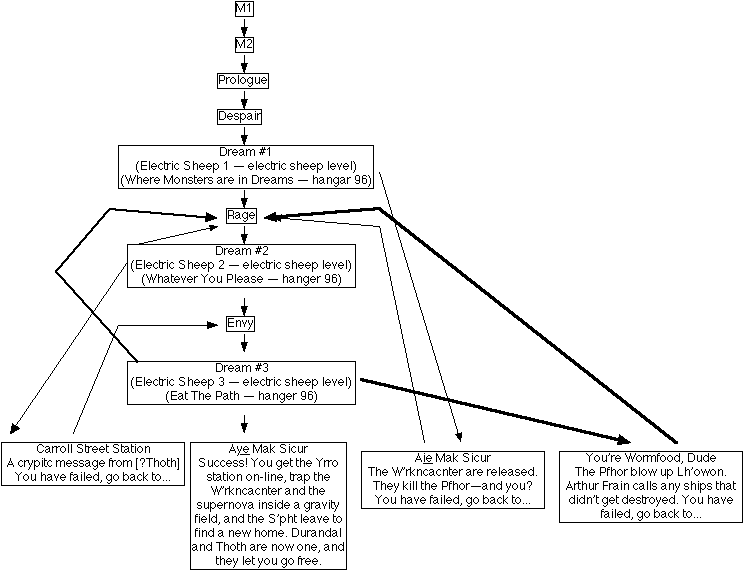
"a line of infinite ends finite finishing
the one remains oblique and pure"
In Marathon Infinity each failed timeline ends with an Electric Sheep level, a so-called 'dream level' and a variation of the level Aye Mak Sicur.
At each Electric Sheep level, except the first one, you have the opportunity to go back (in time) to replay certain timelines (the past) again. These options can be found on the Where Am I? section.
If you choose not to go back but forward at an Electric Sheep level you enter a so-called 'dream level' where you are faced with two choices (not always obvious). These choices are either to proceed to the end of a failed time (a variation of the Aye Mak Sicur level) or find another, hopefully more successful, path (new timeline).
Only in the 'successful' timeline do we not encounter an Electric Sheep level and our path takes us ultimately to Aye Mak Sicur and success.
David Cornwell <goldragonne@earthlink.net> writes:
D espair
R age
E nvy
A ye
M ak
S icur
David ponders on the significance of the level "Aye Mak Sicur" and its dream like variations, and wonders was it all a dream?
Forrest Cameranesi <Pfhorrest@aol.com> writes:
"Despair...
Rage...
Envy...
Aye
Mak
Sicur
i figured it all out...
it all makes sense now
it was as if from an old dream...
...but now i remember
-p4st"
Forrest provides a diagram:

The following is an extract from an unfinished interview with
Greg Kirkpatrick (GK) and Chris Geisel (CG):
HS: The timelines appear to break at the Electric Sheep levels. Each sheep level is followed by a second dream level in which we can take one of two paths. One takes us to a variation on the last level Aye Mak Sicur (namely Aie Mak Sicur, Carrol St. Station, and Your Wormfood Dude) the other to a new timeline or the continuation of an old timeline. The variations on the last level Aye Mak Sicur I take it are failed timelines? Timelines in which we fail to stop the nova and the release of the W'rkncacnter.GK & CG: Right on. Yep... basically this is what would have eventually happened if you'd continued the previous timeline to its conclusion.
Michael Florentin Nielsen <florent@post3.tele.dk> writes:
In the diagram from Forrest Cameranesi it is indicated, that Minf takes place after M2, but I think it is rather obvious that at least some of the episodes are before or at the same time as M2. Eg. take a look at the last term on Thing What Kicks... Next mission Waterloo Waterpark? Futhermore on Confound Delivery we read: "But I [Tycho] sent him [Durandal] a message he won't be able to resist, something only the three of us would understand." Now where have we seen that one before? As a side note: remember the flooding in Charon Doesn't Make Change and the "Damage to dam on the Minor River"? Now the big question is: Am I one person (cyborg) or is it all possible worlds running mad?
Yes, events in Marathon 2 and Infinity run currently but in different timelines. We play the same character but this is not always obvious.
The following is an extract from an unfinished interview with
Greg Kirkpatrick (GK) and Chris Geisel (CG):
HS: The Infinity manual provides us with the first indication that everything is not as it seems. The M2 events at Lh'owon have been rewritten and Durandal is about to meet his demise at the hands of the Pfhor. The Prologue level reaffirms this yet on level 2 we appear to find ourselves journeying back in time and working for Tycho! Are these in effect three different timelines?GK & CG: Yes, the player is jumping from a number of possible futures trying to find the path (eat the path) that will allow him to survive the cataclysm on Lh'owon, and unite him with 11th clan in a way that Durandal never could. How the player is able to do this jumping has to do with the unique interaction between Jjaro technology and sentient creatures.
HS: Thus On Rise Robot Rise (Level 2) we are in a timeline in which we were not kidnapped by Durandal at the end of Marathon but rather captured by the Pfhor along with Tycho at Tau Ceti?
GK & CG: Yes. Tycho wakes you up. Durandal is alone.
Forrest Cameranesi <Pfhorrest@aol.com> writes:
...i thought everyone else might benefit from a better diagram. this one's more accurate, smaller (as in surface area), and easier to read. the red path indicates the shortest route to completeing the game.
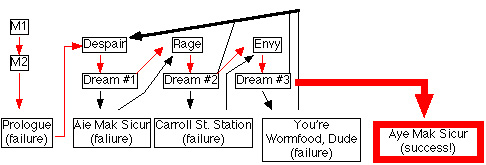
How many failed timelines are there in Marathon Infinity? Four... Five... or more?
As we know Ne Cede Malis is the end of a failed timeline. The Marathon Infinity manual describes a series of events that do not occur in Marathon 2. But the events described in the manual are different from those described by Durandal on Ne Cede Malis.
In the Infinity manual, Tfear describes how they tricked Durandal when he arrived at Lh'owon, disabled his ship and forced him to "retreat to a heretofore undetected station located in an asteroid field on the fringe of the Lh'owon system." This is presumably the Jjaro space station. Although Durandal has evaded capture he is trapped on the station. In order to make sure of Durandal's destruction Tfear orders the deployment of the trih xeem. All hell breaks loose.
On Ne Cede Malis, Durandal says that he "slaughtered the Pfhor naval garrison and the Western Arm of their Battle Group Seven." But in their final gasp they use the trih xeem. Chaos is released. Durandal acknowledges that he is doomed to die on the Jjaro space station but says that you have a chance to escape if you can find a way onto Tycho's ship which is nearby.
So these are two different timelines... or else someone is telling major porkies. ;-)
So perhaps we have the following timelines:
Events in Marathon 2 leading to the deployment of the trih xeem.
...
New timeline leading to the events in the Infinity manual and failure.
New timeline leading to Ne Cede Malis and failure.
New timeline leading to Aie Mak Sicur and failure.
New timeline leading to Carroll Street Station and failure.
New timeline leading to You're Wormfood, Dude and failure.
New timeline leading to Aye Mak Sicur and success.
Also given that Ne Cede Malis is the end of a failed timeline then Electric Sheep One can't be number 'one' since logic would dictate that there was an Electric Sheep level before Ne Cede Malis and even one before that. Perhaps many more before that one.
Just something to think about...
Forrest <forrest@bungie.org> provides another (more detailed) diagram for the many different timelines in Infinity and the apparent similarities between timelines.
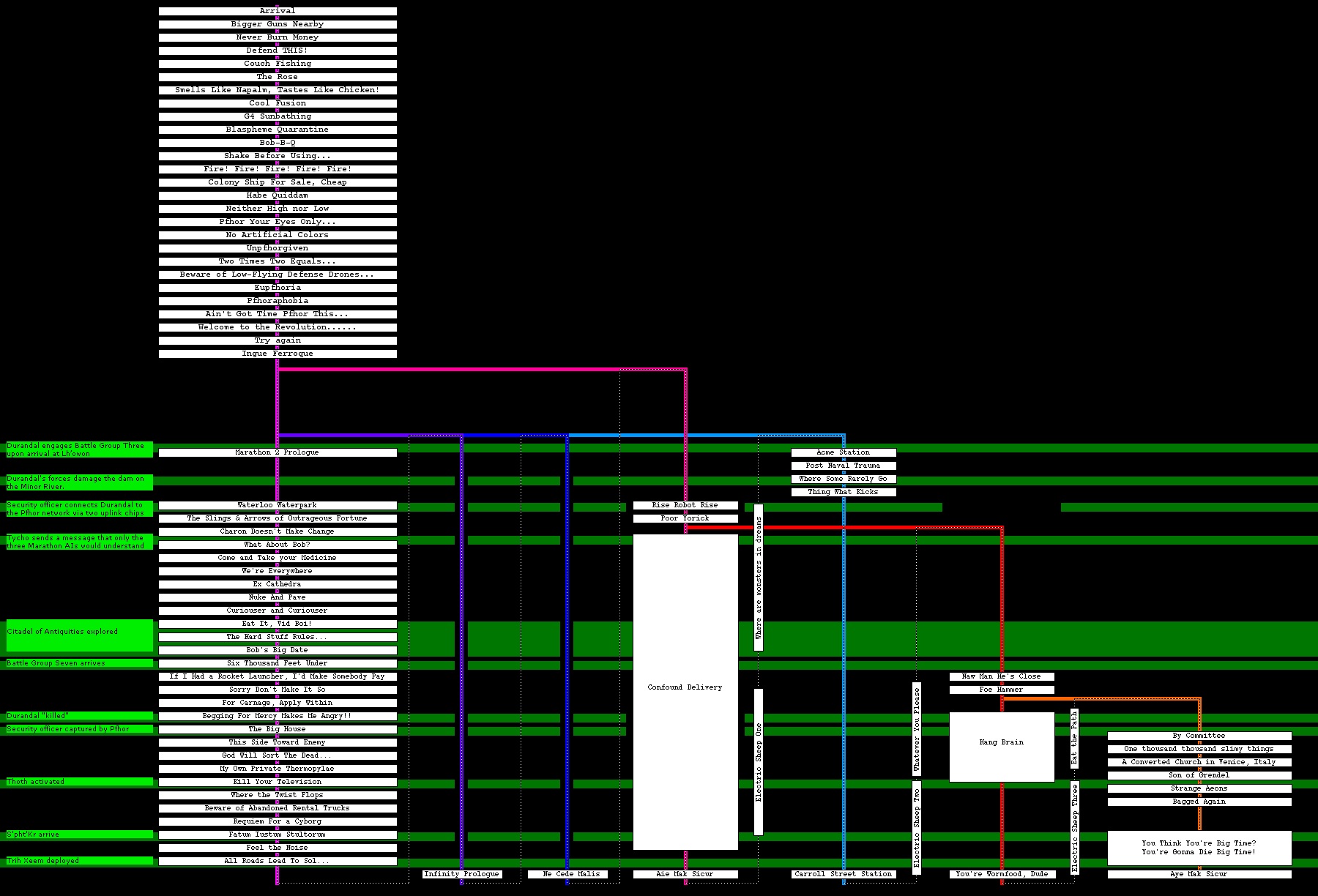
Confused? Well Forrest explains:
The thick, solid-color lines running mostly downward represent objective timelines; up is past,
down is future. The dotted black-and-white line running down and between those lines represents
the player-character's subjective timeline. The white boxes with words in them are the levels,
obviously. The green horizontal bars mark events in time, showing how they connect to different
levels in different timelines; if a green bar passes fully behind a timeline, that indicates
that that event occurs in that timeline, otherwise if it breaks before and then resumes past
a timeline, that indicates that it does not occur in that timeline. (E.g. the security offices
does not connect Durandal to the Pfhor network via two uplink chips in the timeline that
begins with "Rise Robot Rise", because he's with Durandal at that point).The timelines are color-coded just by their relations to each other. The first timeline (M1->M2)
is magenta just for contrast with the green horizontal bars. The timelines branching off from
that where you go with Tycho get progressively warmer (rose, red, orange), while the ones
where you go off with Durandal get progressively cooler (purple, blue, aqua).The breaks between timelines are determined by the dream level sequences (Electric Sheep levels
and those immediately following them, which are shown rotated since they don't really occur at
any point in time per se). The placement of individual levels in time (vertical placement) is
determined based on references to events mentioned on those levels, which I began compiling back
in this post, which was what originally was going to build up to this diagram, but I apparently
got distracted from until recently.The relation between different timelines is just inferred by what appears to have happened in them:
In the Infinity Prologue timeline, we may assume things went more or less as in M2 except as
specified otherwise, which appears to be everything since Durandal arrived at Lh'owon, although
the trih xeem was still deployed for some reason despite Durandal's crushing defeat. Similarly
in the Ne Cede Malis timeline, except the space battle went different, and nevertheless Durandal
ended up cornered on the Yrro station. Then we jump to a timeline where Durandal never took us
from Tau Ceti and we ended up with Tycho instead, which ended up driving many of the same events
from M2 to happen anyway, just with us on the other side. Then we jumped a timeline just like M2
(went with Durandal) except where we woke up early and helped in some of the earlier battles...
but that ended up going straight back to M2 all over again. So we jump to a variant of the Tycho
timeline, except do things differently so the same shit doesn't quite happen again... which still
ends up failing somehow, so we jump back and try a slightly different variant of that timeline,
and THAT ends up working.
Back in Jan 18, 2002 SiliconDream <querl@uclink4.berkeley.edu> posted the following
Infinity timeline diagram to the Story forum. The diagram describes the multiple timelines in
Infinity and the similarities between timelines.
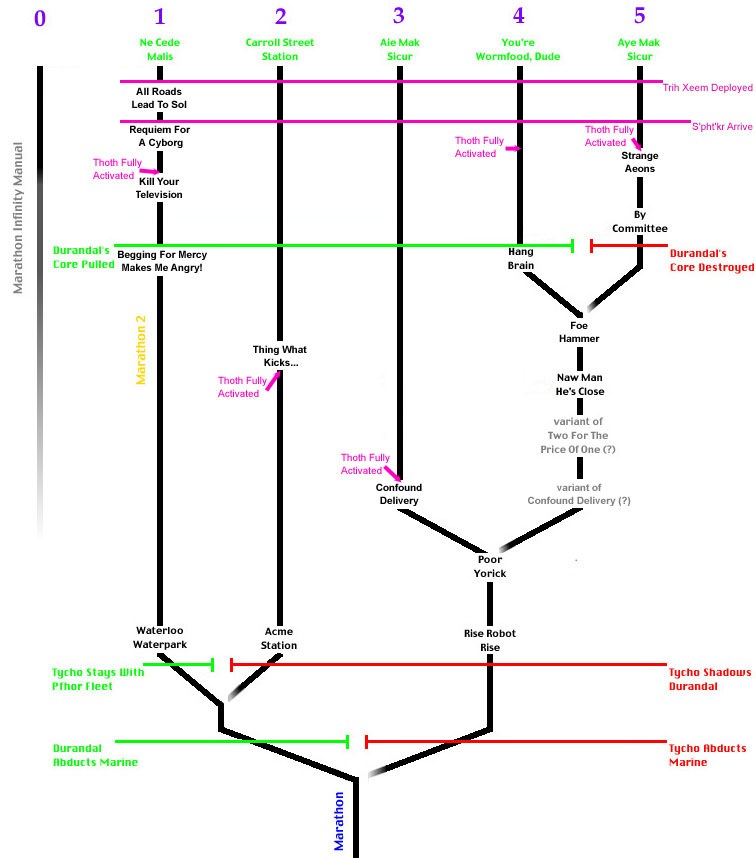
SiliconDream explains his diagram as follows:
Claude loves you all, so he offered to host the picture. It ain't pretty, but it's functional.
I thought about representing the timeline jumps too, but I figured that would just obscure things.
Lavender labels refer to events that happen on every timeline; red and green labels refer to events
that occur in two different versions on different timelines.Couple notes:
I've kept the manual timeline as a separate one, but I don't have strong evidence that it's not
(as others have suggested) T2 or a variant of it.I've listed T4 as a timeline where Durandal's core was pulled. A little while ago, we discussed
whether perhaps his core was destroyed but his trap went off anyway in this timeline. But I don't
think we were any more final about destroying his core here than in T1's Begging for Mercy. We
mercy-killed him there too, but the Pfhor downloaded his data first. It seems likely to me that
things went down simlarly in T4. This similarity would explain exactly how he broke out of Tycho's
prison in T1 (a feat he was awfully coy about recounting); he "disgorged a thousand wriggling worms"
into the S'pht consciousness, converting all the newly-arrived Compilers, who were probably then
the agents of his escape.There's no obvious single point of divergence between T3 and T 4/5. In T3, you manage to activate
Thoth before Tycho sends you to kill Durandal; in T 4/5, you don't. Also, Tycho attacks Durandal
earlier (relative to the arrival of BG7) in T3 than in T 4/5. So it would appear that the point
of divergence was some minor event which put Tycho a little behind schedule in T4/5; he and you
most likely tried to do all the same stuff, but did it a little later than in T3. Hence my
speculation that the early parts of T4/5 just after the branching point are very similar to
the same time period of T3.Enjoy. If anything major's wrong, let me know and I'll fix it.
SiliconDream
From a historical point of view this diagram is important as it showed, perhaps for the first time,
that the Marathon Infinity manual text was a separate distinct timeline.
However, the diagram is inaccurate as it appears to show that Ne Cede Malis follows on directly
after the events in Marathon 2. Yet on Ne Cede Malis, Durandal tells us:
It's too bad, perhaps if I could have delayed
the Pfhor from using their weapon, I could
have sent you to explore the ruins of Lh'owon,
As mentioned above, Ne Cede Malis is the end of another different failed timeline.
One of at least six timelines in Infinity + Marathon 2... makes... seven! ;-)
Bruce Morrison <bruce@ngmoco.com> writes concerning the numbering of the Electric Sheep levels:
There's a part about how many failed timelines there are. You state:
"Also given that Ne Cede Malis is the end of a failed timeline then Electric Sheep One can't be
number 'one' since logic would dictate that there was an Electric Sheep level before Ne Cede Malis
and even one before that. Perhaps many more before that one.Just something to think about..."
Cyborgs and AIs don't start counting at 1 like humans do. They start at 0. Just take the Vidmaster
Oath and try to jump to a level index.So Electric Sheep One would be the 2nd Electric Sheep level.
The Marathon Infinity timelines tend to get discussed in cycles, with each iteration
we seem to understand a little more, or a little less, depending on your point of view
or frame of reference.
Back in January 2011, Forrest of B.org began another cycle of discussion and
went on to produce another iteration of his Infinity timeline chart. This was a
more expansive vision of his previous charts.
Now in July 2013, the discussion has started again and Forrest has posted his
Infinity timeline chart... again. You can now see it below.
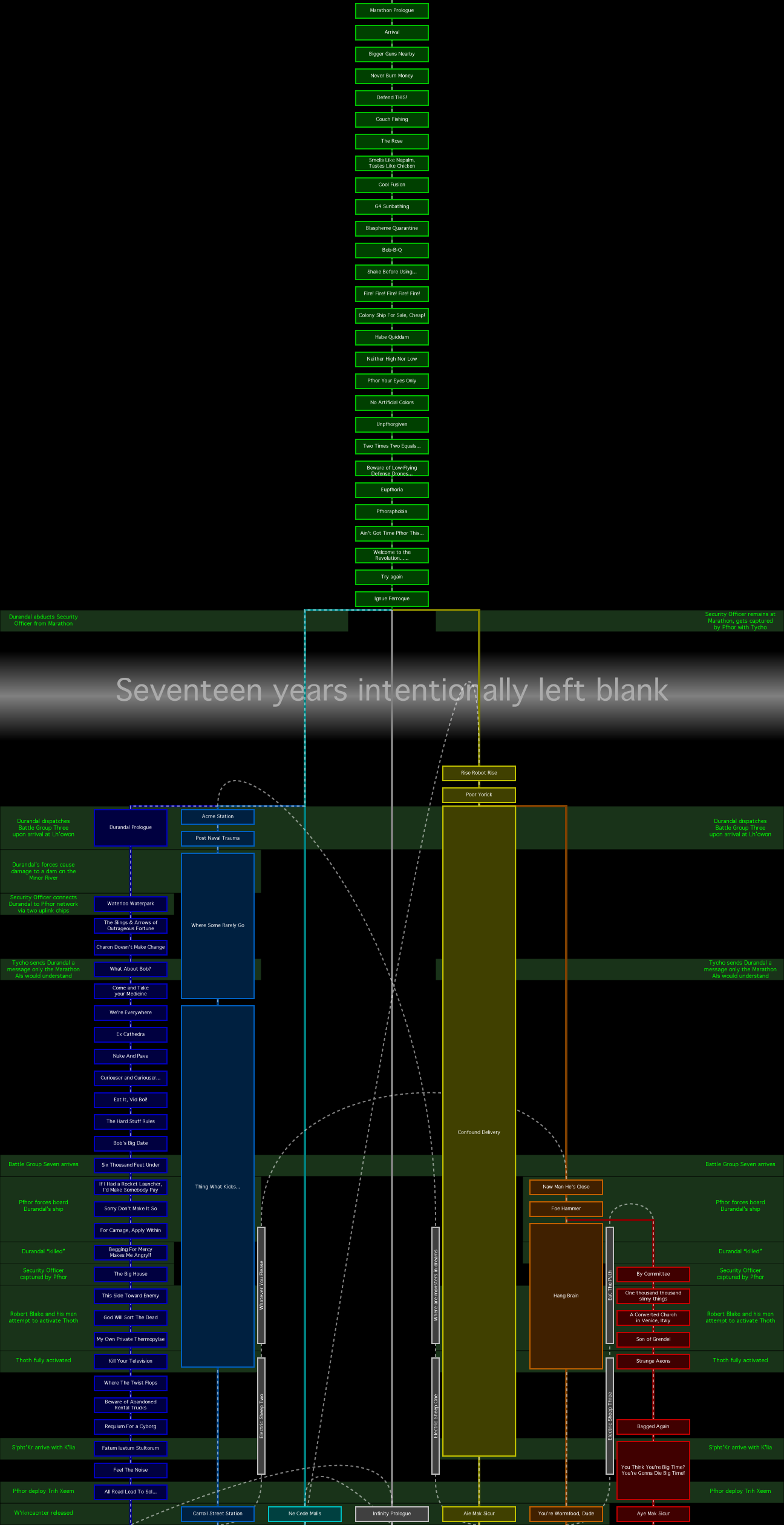
About the above chart, Forrest writes:
I realized while researching this that this approach isn't exactly perfect, because
in some timelines the events occur in different orders. Thankfully all of those
times seem to be where they occur closer together in time, or at least all on the
same level, so that doesn't hugely impact this diagram. However, for example on
"Thing What Kicks", it's implied that something like "Waterloo Waterpark" will
follow, as well as exploration of the Citadel of Antiquities ala "Eat It, Vid Boi"
etc, which is not accurately indicated by a diagram in this form. I'm not really
sure how well it could be accurately indicated, but if we come up with something
elegant I'll be happy to make yet another one.
Hopper <hopper@whpress.com> makes the following observations about the chart.
The dotted lines represent the normal order a player would encounter everything -- thus,
Marathon 2 followed by Infinity's manual followed by the Infinity levels in order. As
you can see, that doesn't tell you much about in-universe chronology.You could take it as the SO's personal chronology, since it's natural to assume his
knowledge of all the timelines matches our own, but I don't think there's really
anything to confirm or deny that assumption beyond the genre conventions (we are
the SO as we play, so we share his experiences and knowledge along with his eyesight).
Forrest <forrest@bungie.org> goes on to add:
If the SO's personal chronology doesn't match the order of revelation in the games,
then I don't know how we can answer the question about his in-universe chronology,
other than throwing up our hands and saying that we're just witnessing bits of the
lives of many alternate versions of the SO until we (the players, not the
player-character) find one where he wins, but that's a little too meta even for
Infinity and not very fulfilling (and what sense does it make of dream levels, etc?)It would all make so much more sense if the Infinity Prologue and Ne Cede Malis clearly
took place following All Roads Lead To Sol: M2 as we know it happens, the W'rkncacnter
is released, Durandal gets trapped on the Jjaro station, Tfear begs for forgiveness,
and we get sent back across time and timelines to just prior to the start of M2 in a
timeline where Durandal didn't abduct us. That goes just as badly so we're sent back
again to a timeline where Durandal did abduct us but woke us up earlier. That goes
just as badly so we're back to a Tycho-lead timeline again, one that lasted a bit
longer but still goes all sour eventually. So then we go back and try a slight
variation on that which ends up preventing the W'rkncacnter's release. Voila,
everything makes nice linear sense.But aside from the question of whether Ne Cede Malis and the Infinity Prologue
are the same timeline or not, Ne Cede Malis is clearly not the end of Marathon 2,
as Durandal muses about how if only he had had time to send you exploring Lh'owon,
things might have turned out different, whereas M2 is all about exploring Lh'owon.
So that option is out.It could also make sense if the final timeline ended the way M2 did, or ended with
us going on the start of M2 (as the "Thing What Kicks..." timeline almost does). If
that were the case, then it could be argued that Infinity is an "interquel"; that
we originally went off with Tycho, that ended in ruin, we tried a couple alternate
timelines, and eventually settled on the M2 one where somehow things work out.
Except give what we know from the other timelines the M2 one shouldn't work out,
and Infinity clearly ends in a different timeline than M2 takes place in.Basically it seems that Infinity takes place entirely in different timelines to
Marathon 2, and there is no indication of where they may connect with each other
besides the fact that we play Infinity after we play M2. That still leaves unexplained
how the M2 timeline apparently has a long non-W'rk'd-up future ahead of it when by
all accounts it shouldn't, and it also doesn't explain why whatever is sending us
around time and timelines would show us two alternate failed timelines before we
get to see the one we were already in fail. But that's what seems to happen, and
with no basis to think anything otherwise, I think that's all we're really got to
go on.
Back in 2001 during the Volunteers series Tim "Alfred Mordeir" Branin made an interesting
observation about the
level "Where are monsters in dreams" and the two exit messages. He wrote:
Correct me if I'm wrong, but I think that the exiting messages in "Where are Monsters in Dreams" are mixed up. Because in the other two dream levels the "Armless legless corpse" messages all lead to the incorrect "Aye Mac Sicur" failure levels. It seams to me that those "Hangar 96" messages are a metafore for the destruction brought on by the Trih Xeem. "I did this or I could have stopped this" is the lamentaion over the player's apparent failure.
Tim is indeed correct that the placement of the Hangar Ninety Six terminal message appears inconsistent on "Where are Monsters in Dreams".
On the other two Dream levels Hangar Ninety Six takes you to the end of a failed timeline. Experiencing these adds content to the story and the intent may have been to make them harder to find for the casual player and a reward for the more curious or adventurous.
This is certainly true on "Whatever You Please". The higher (harder) path on this level takes you to the Hangar Ninety Six terminal and then on to the end of a failed timeline. For most people the lower path is easier and the more obvious option.
On "Eat the Path" the less obvious (secret) path takes you to the Hangar Ninety Six terminal and then on to the end of a failed timeline. Again most people would have taken the more obvious path. However, once you take this path for most people there would have been no way back. Which kind of contradicts the opening terminal text...
Find the right way down through the maze, to the food, then find the exit. Push the exit button. If the food tastes awful, don't eat it, go back and try another way.
On "Where are monsters in dreams" the Hangar Ninety Six terminal is actually a second message displayed on the 1st terminal. Since the map is designed to take you back to his terminal before you solve the 'bridge' puzzle and fully complete the level the intent may have been for people to access this terminal again and be whisked off to Acme Station without visiting the failed timeline. This would be considered the easier path as it doesn't require solving the bridge puzzle. Yet it displays the Hangar Ninety Six terminal and does not lead to the failed timeline.